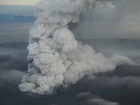News

30th Nordic Geological Winter Meeting
The 30th Nordic Geological Winter Meeting will be held in Reykjavík in January 2012.
Read more
The reception at the Icelandic Met Office and projects
The Icelandic Met Office's new reception was opened on December 16th at Bústaðavegur 7. IMO is now located in two adjacent buildings, Bústaðavegur 7 and 9.
Read more
Global Cryosphere Watch
The cryosphere collectively describes elements of the Earth System containing water in its frozen state and includes solid precipitation, snow cover, sea ice, lake and river ice, glaciers, ice caps, ice sheets, permafrost, and seasonally frozen ground. The Global Cryosphere Watch (GCW) should enhance the capability of the research community and operational services to predict the future state of the cryosphere.
Read more
The Annual Meeting of CRAICC held in Iceland
The ANNUAL Meeting of the CRAICC Project, Cryosphere-Atmosphere Interactions in a Changing Arctic Climate, is held in Iceland between Oct 10 and 14, 2011. On behalf of IMO the project SVALI, Stability and Variations of Arctic Land Ice, is presented, and a field trip arranged.
Read more
Earthquake activity in Katla volcano October 2011
05.10.2011. Earthquakes are taking place in the Katla volcano, within the volcano's caldera, which is covered by the Mýrdalsjökull ice-cap. The current period of unrest began in July 2011 when a short-lived glacial flood burst from Mýrdalsjökull in connection with increased seismicity. Since then, several hundred micro-earthquakes have taken place within the area of the caldera.

42nd Nordic Seismology Seminar
The 42nd Nordic Seismology Seminar will be held in Reykjavík 5 – 7 October 2011. It is hosted in turn by each of the Nordic Countries and is therefore in Iceland every fifth year.
Read more
Risk assessment of volcanic eruptions
The Icelandic government approved
on August 26th a proposal for the preparation of a general risk assessment regarding volcanic eruptions in Iceland. Studies indicate that volcanic activity in Iceland rises
and falls.

Workshop on Jökulhlaup Hazards
The April 2010 eruption of Eyjafjallajökull represented the first modern-day opportunity in Iceland to study jökulhlaups from an ice-capped stratovolcano. On Thursday 25 August 2011, flooding issues from the eruption were explored in an interactive workshop, held at IMO.
Read more
IMO receives Special Achievement Award for Exceptional Application of Geospatial Technology
This award acknowledges vision, leadership, hard work, and innovative use of Esri's geographic information system (GIS) technology.
Read more
Glacier-outburst flood from Mýrdalsjökull
The jökulhlaup (glacier-outburst flood) which came from Mýrdalsjökull early morning Saturday 9th July, and swept away a bridge over Múlakvísl, came from ice cauldrons in southeastern part of the Katla volcano.
Read more
Iceland acquires full voting rights at ECMWF
As a Member State, Iceland acquired full voting rights at the ECMWF Council, starting at the 75th Council session on 16 and 17 June 2011.
Read more
The crater at Grímsvötn
The eruption site was observed during a flight yesterday evening. Water is clearly seen in the fissure. The eruptive activity is now concentrated at two small vents surrounded by a thin circle of tephra.
Read more
Ash measurements
The Icelandic Meteorological Office uses a LIDAR instrument to measure ash layers and weather radars to monitor the eruption plume.
Read more
Eruption has started in Grímsvötn
An eruption began at Grímsvötn volcano at approximately 17:30 UTC, May 21st 2011.
Read more
Safe travelling
The web-site Safetravel.is provides important information for tourists travelling in Iceland.
Read more
A year since the Eyjafjallajökull eruption began
The eruption in Eyjafjallajökull volcano began 14th April 2010. For a review, some links are provided as well as new photographs of the summit crater.
Read more
Iceland a member of ECMWF
Iceland will become ECMWF’s nineteenth Member State. As a full Member State, Iceland will acquire full voting rights at the ECMWF Council from the date of entry into force of the agreement. The agreement will enter into force on the first day of the second month following the deposit of its instrument of accession.
Read more
NONAM organises a PhD summer school
Are you a PhD student with an interest in adaptive management in relation to climate change? NONAM and FIVA organize a PhD summer school in Copenhagen in August. Deadline for registration is 30 April 2011. Applicants must include a brief description of their PhD or research project and a recommendation from their supervisor supporting their participation.
Read more
The weather in Iceland 2010
The weather in Iceland was highly unusual in 2010. This applies especially to the South and West parts of the country where the year was one of the warmest and driest on record and the snowfall was unusually light. The barometric pressure reached the highest annual value on record. The climate was very favourable and windstorms markedly fewer than usual.
Read more



